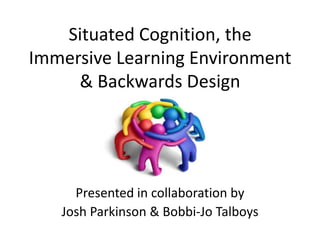
Situated Cognition, the Immersive Learning Environment & Backwards Design
- 1. Situated Cognition, the Immersive Learning Environment & Backwards Design Presented in collaboration by Josh Parkinson & Bobbi-Jo Talboys
- 3. Situated Cognition • Theorizied by John Seely Brown; Allan Collins; Paul Duguid – Learning in the classroom and life experiences association. – Knowledge is doing. – Stoves are Hot!! • Developed through activities – Set of tools – Learning as a result of culture. – Real life into learning. – Learning not always into real life. – Book Smart vs. Street Smart John Seely Brown Allan Collins Paul Duguid
- 4. Developing a Learning Environment based upon Situated Cognition Theory Situated Cognition in Theoretical and Practical Context Brent G. Wilson and Karen Madsen Myers http://carbon.ucdenver.edu/~bwilson/SitCog.html • Think beyond the psychology-based learning theories: ⁻ Anthropology ⁻ Critical theory ⁻ Political science • Not one theory is better; be flexible less rigid. Two major points:
- 5. Situated Cognition Principles: Learning Environments 11 principles to follow when creating a learning environment based off of the Situated Cognition Theory Table taken from: Wilson, B. G., & Myers, K. M. (2000). Situated cognition in theoretical and practical context. Theoretical foundations of learning environments, 57-88.
- 6. Thinking and learning make sense only within particular situations.Learning in context •All thinking, learning, and cognition is situated within particular contexts; there is no such thing as non-situated learning. People act and construct meaning within communities of practice.Communities of practice •These communities are powerful repositories and conveyors of meaning and serve to legitimate action. Communities construct and define appropriate discourse practices. Learning is seen in terms of belonging and participating in communities of practice. Learning as active participation •Learning is seen as a dialectical process of interaction with other people, tools, and the physical world. Cognition is tied to action - either direct physical action or deliberate reflection and internal action. To understand what is learned is to see how it is learned within the activity context. Knowledge is located in the actions of persons and groups.Knowledge in action •Knowledge evolves as we participate in and negotiate our way through new situations. The development of knowledge and competence, like the development of language, involves continued knowledge-using activity in authentic situations. Cognition depends on the use of a variety of artifacts and tools, chiefly language and culture.Mediation of artifacts •These tools and constructed environments constitute the mediums, forms, or worlds through which cognition takes place. Problem solving involves reasoning about purposes in relationship to the resources and tools which a situation affords. Tools embody the history of a culture. Tools and artifacts as cultural repositories •They enable thought and intellectual processes and constrain or limit that thought. They also provide powerful means of transmitting culture.
- 7. Cognitive tools include forms of reasoning and argumentation that are accepted as normative in society. Rules, norms, and beliefs •Using a tool in a certain manner implies adoption of a cultural belief system about how the tool is to be used. Situations make sense within an historical context, including the past experiences and interactions of participants, as well as anticipated needs and events.History •Cultures, through tools, artifacts, and discourse practices, embody the accumulated meanings of the past. Cognition can best be understood as a dynamic interplay between individual and social levels.Levels of scale •Focus on one level, while assuming constancy or predictability at the other, is bound to at least partly misinterpret the situation. Just as situations shape individual cognition, individual thinking and action shape the situation.Interactionism •This reciprocal influence constitutes an alternative conception of systemic causality to the more commonly assumed linear object causality. People have multiple identities, which can serve as tools for thinking and acting. Identities and constructions of self •People’s notion of self—of continuing identity, separate from others yet belonging to various groups — is a constructed artifact with many uses.
- 8. The Immersive Learning Environment • Fosters the constructivist learning theory – Embeds learning within relevant environments – Requires social negotiation for learning – Presents multiple perspectives and representations – Encourages active self-directed learning – Supports metacognitive learning strategies • Creates experiential learning opportunities – Knowledge is interwoven throughout the environment – Learner builds interpretations through interactions and experiences – Connects learners with various backgrounds from which to learn about experiences – Creates collaboration opportunities – Creates opportunities for knowledge transfer between experiences
- 9. Opportunities for Learning in Immersive Environments • Virtual Worlds: Second Life, OpenSim, SmallWorlds • MMORPG’s, MMOG’s (World of Warcraft) • Learning Management Systems (Angel, Moodle, Blackboard) • MOOC’s (massive open online courses) • Simulation (Google Earth, flight simulators) • Educator & Student Websites • Online tools including: Facebook, Youtube, Prezi, Slideshare, Powtoons, VideoScribe, Skype, LinkedIn, Wordle, TED, ERIC, Purdue Online Writing Lab, Blogger, WordPress, etc.
- 10. Understanding by Design: Backward Design Understanding by design, created by Grant Wiggins and Jay McTighe, presents a framework for curriculum development. with the end goal in mind.
- 11. Backward Design Based on the following principles: • The development and deepening of student understanding • Application of knowledge and skills to reveal evidence of understanding • Defining clear priorities and purposes • Routinely reviewing curriculum and assessment designs to meet standards • Students have opportunities to explain, interpret, apply, shift perspective, empathize, and self-assess • Educators work together collaboratively to design, share and critique studies Studies have shown: • Addresses both learner and educator needs • Thrives on big ideas with a central focus for lasting educational value • Students display a higher level of performance • Students are better able to set attainable goals • Students make connections between content and other disciplines, linking activities, materials, and resources to goals
- 12. “To begin with the end in mind means to start with a clear understanding of your destination. It means to know where you’re going so that you better understand where you are now so that the steps you take are always in the right direction.” – Stephen Covey